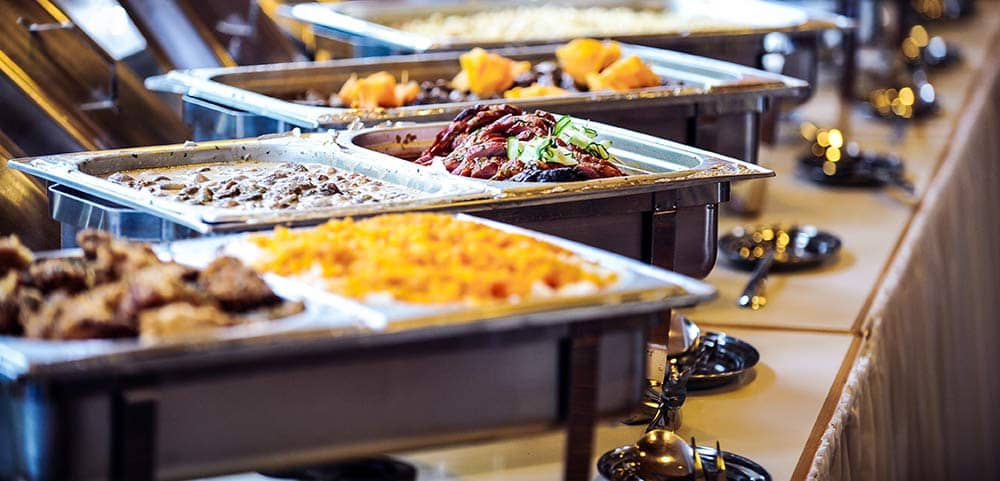 โทร :
+86 18681515767
โทร :
+86 18681515767
 อีเมล์ :
marketing@jtspeedwork.com
อีเมล์ :
marketing@jtspeedwork.com
 โทร :
+86 18681515767
โทร :
+86 18681515767
 อีเมล์ :
marketing@jtspeedwork.com
อีเมล์ :
marketing@jtspeedwork.com
ปฏิวัติการรับประทานอาหารแบบไร้สัมผัส: RFID ช่วยเพิ่มประสิทธิภาพการสั่งอาหารและชำระเงินในร้านอาหารอย่างชาญฉลาดได้อย่างไร

ในช่วงไม่กี่ปีที่ผ่านมา บริการแบบไร้สัมผัสได้รับการพัฒนาอย่างรวดเร็วทั่วโลก โดยเฉพาะอย่างยิ่งในอุตสาหกรรมร้านอาหาร ซึ่งโซลูชันอัจฉริยะและบริการตนเองได้กลายมาเป็นสิ่งจำเป็นสำหรับการปรับปรุงประสิทธิภาพการดำเนินงานและประสบการณ์ของลูกค้า เทคโนโลยี RFID (Radio Frequency Identification) ซึ่งมีประสิทธิภาพสูง แม่นยำ และมีความสามารถในการทำงานอัตโนมัติ ได้กลายมาเป็นปัจจัยสำคัญที่ช่วยให้ร้านอาหารอัจฉริยะสามารถนำระบบสั่งอาหารและบริการชำระเงินด้วยตนเองมาใช้ได้ บทความนี้จะเจาะลึกว่า RFID ช่วยอำนวยความสะดวกให้กับบริการรับประทานอาหารแบบไร้สัมผัสได้อย่างไร และตรวจสอบการใช้งาน ข้อดี และแนวโน้มในอนาคตของ RFID ในร้านอาหารอัจฉริยะ
RFID เป็นเทคโนโลยีการสื่อสารแบบไร้สายที่ใช้คลื่นแม่เหล็กไฟฟ้าเพื่อระบุวัตถุและดึงข้อมูลที่เกี่ยวข้องโดยอัตโนมัติ ส่วนประกอบหลัก ได้แก่ แท็ก RFID เครื่องอ่าน และระบบการจัดการแบ็กเอนด์ แท็ก RFID ประกอบด้วยชิปและเสาอากาศ ซึ่งช่วยให้สามารถจัดเก็บและสื่อสารข้อมูลกับเครื่องอ่านได้ เครื่องอ่าน RFID มีทั้งแบบถือด้วยมือและแบบยึดติด อ่านหรือเขียนข้อมูลแท็ก ระบบการจัดการแบ็กเอนด์จะประมวลผล จัดเก็บ และวิเคราะห์ข้อมูลเพื่อให้สามารถจัดการได้อย่างชาญฉลาด เมื่อเปรียบเทียบกับเทคโนโลยีบาร์โค้ดแบบเดิม RFID ให้การระบุที่เร็วกว่า ความสามารถในการป้องกันการรบกวนที่ดีกว่า และความสามารถในการอ่านแท็กหลายรายการพร้อมกัน จึงเหมาะอย่างยิ่งสำหรับการใช้งานในร้านอาหารอัจฉริยะ
ร้านอาหารอัจฉริยะใช้ประโยชน์จากเทคโนโลยี RFID เพื่อทำให้กระบวนการทั้งหมดตั้งแต่การสั่งอาหารไปจนถึงการจ่ายเงินเป็นไปโดยอัตโนมัติ ซึ่งช่วยเพิ่มประสิทธิภาพในการดำเนินงานและประสบการณ์ของลูกค้า ในการสั่งอาหารด้วยตนเอง ลูกค้าสามารถใช้เมนูอัจฉริยะที่รองรับ RFID ได้ โดยบัตรเมนูแต่ละใบจะมีชิป RFID ฝังอยู่ ซึ่งลูกค้าสามารถแตะบนเครื่องอ่านแบบตั้งโต๊ะหรือแบบบริการตนเองเพื่อเรียกดูเมนู เลือกรายการอาหาร และสั่งซื้อ นอกจากนี้ ระบบยังสามารถบันทึกการตั้งค่าของผู้ใช้ได้ ซึ่งให้คำแนะนำเฉพาะบุคคลเพื่อปรับปรุงประสบการณ์การสั่งอาหาร
สำหรับการเก็บอาหารโดยอัตโนมัติ ถาดหรือภาชนะของแต่ละจานสามารถติดตั้งแท็ก RFID ที่มีข้อมูล เช่น ชื่ออาหาร ราคา และเวลาในการเตรียม เมื่อลูกค้ามารับอาหาร เครื่องอ่าน RFID จะบันทึกการเลือกโดยอัตโนมัติ ช่วยลดการดำเนินการด้วยตนเองและเพิ่มประสิทธิภาพในการบริการ
ในระบบชำระเงินอัจฉริยะ เทคโนโลยี RFID ช่วยให้ชำระเงินได้อย่างรวดเร็วและไม่ต้องสัมผัส ซึ่งแตกต่างจากกระบวนการชำระเงินแบบเดิมที่ต้องเรียกเก็บเงินด้วยตนเอง ระบบ RFID จะอ่านแท็กของจานทั้งหมดบนถาดโดยอัตโนมัติ คำนวณราคารวม และให้ลูกค้าชำระเงินด้วยบัตรหรือการชำระเงินผ่านมือถือ วิธีนี้ช่วยลดเวลาการรอคอย เพิ่มประสิทธิภาพการชำระเงิน และลดต้นทุนแรงงาน
RFID ยังมีบทบาทสำคัญในการจัดการสินค้าคงคลังที่แม่นยำ ร้านอาหารสามารถติดแท็กส่วนผสมและรายการอาหารด้วย RFID เพื่อตรวจสอบระดับสต็อกแบบเรียลไทม์ เพิ่มประสิทธิภาพแผนการซื้อและการเติมสินค้า และลดของเสียให้เหลือน้อยที่สุด เมื่อใช้ร่วมกับเซ็นเซอร์วัดอุณหภูมิและความชื้น RFID จะช่วยติดตามวันหมดอายุของอาหาร ช่วยให้มั่นใจถึงความปลอดภัยของอาหารและปรับปรุงการควบคุมคุณภาพ
นอกจากนี้ RFID ยังรองรับการเป็นสมาชิกอัจฉริยะและบริการส่วนบุคคล ลูกค้าที่ใช้บัตรสมาชิกที่รองรับ RFID หรือสายรัดข้อมืออัจฉริยะสามารถบันทึกพฤติกรรมการรับประทานอาหารของตนได้ ทำให้ร้านอาหารสามารถเสนอคำแนะนำเฉพาะบุคคลและส่วนลดพิเศษตามประวัติการสั่งซื้อของลูกค้าได้ ซึ่งจะช่วยเพิ่มความภักดีของลูกค้าและปรับปรุงความพยายามทางการตลาดที่ตรงเป้าหมาย
เมื่อเปรียบเทียบกับวิธีการสั่งซื้อและชำระเงินด้วยมือแบบดั้งเดิม RFID มีข้อได้เปรียบที่สำคัญหลายประการ โดยเพิ่มประสิทธิภาพในการสั่งซื้อและชำระเงิน ลดเวลาการรอคอยของลูกค้า นอกจากนี้ยังช่วยลดต้นทุนแรงงานด้วยการลดการพึ่งพาพนักงานบริการและพนักงานเก็บเงิน ทำให้ร้านอาหารสามารถจัดสรรทรัพยากรได้มากขึ้นเพื่อปรับปรุงคุณภาพอาหารและประสบการณ์ของลูกค้า RFID ช่วยเพิ่มความปลอดภัยของอาหารโดยให้สามารถติดตามแหล่งที่มาของอาหารและเงื่อนไขการจัดเก็บได้อย่างโปร่งใส พร้อมทั้งเพิ่มประสิทธิภาพการจัดการสินค้าคงคลังเพื่อลดของเสีย การโต้ตอบด้วย RFID แบบไร้สัมผัสทำให้การรับประทานอาหารถูกสุขอนามัยและสะดวกสบายมากขึ้น สอดคล้องกับความคาดหวังของผู้บริโภคในยุคใหม่ต่อบริการที่ปลอดภัยและราบรื่น นอกจากนี้ ระบบ RFID ยังสร้างข้อมูลผู้บริโภคที่มีค่า ทำให้ร้านอาหารสามารถนำกลยุทธ์การตลาดที่แม่นยำและคำแนะนำที่ชาญฉลาดมาใช้ได้
แม้ว่าเทคโนโลยี RFID ในร้านอาหารอัจฉริยะจะมีการใช้งานที่น่าสนใจ แต่กลับต้องเผชิญกับความท้าทายหลายประการ ต้นทุนการนำไปใช้งานเบื้องต้นซึ่งรวมถึงฮาร์ดแวร์ (เครื่องอ่าน แท็ก) และการรวมระบบอาจสูง ทำให้ต้องลงทุนจำนวนมาก โดยเฉพาะอย่างยิ่งสำหรับร้านอาหารขนาดเล็กและขนาดกลาง นอกจากนี้ ปัญหาความเข้ากันได้ระหว่างมาตรฐานและอุปกรณ์ RFID ที่แตกต่างกันอาจส่งผลต่อการรวมระบบและการทำงานร่วมกันของข้อมูล นอกจากนี้ เนื่องจากระบบ RFID รวบรวมข้อมูลของผู้บริโภค การรับรองความเป็นส่วนตัวและความปลอดภัยของข้อมูลจึงเป็นข้อกังวลสำคัญสำหรับผู้ประกอบการร้านอาหาร
เมื่อมองไปข้างหน้า เมื่อต้นทุน RFID ลดลงและระบบรับประทานอาหารอัจฉริยะยังคงพัฒนาต่อไป การผสานรวม AI บิ๊กดาต้า และ IoT จะช่วยเพิ่มประสิทธิภาพการทำงานอัตโนมัติของร้านอาหารได้มากขึ้น ตัวอย่างเช่น ผู้ช่วยสั่งอาหารอัจฉริยะที่ขับเคลื่อนด้วย AI สามารถวิเคราะห์ความต้องการของลูกค้าและแนะนำตัวเลือกเมนูส่วนบุคคล ร้านอาหารอัตโนมัติเต็มรูปแบบที่ขับเคลื่อนด้วย RFID ซึ่งรวมการเตรียมอาหารด้วยหุ่นยนต์และระบบชำระเงินแบบไร้สัมผัสจะแพร่หลายมากขึ้น นอกจากนี้ การผสมผสาน RFID เข้ากับเทคโนโลยีบล็อคเชนจะช่วยให้สามารถตรวจสอบย้อนกลับอาหารที่โปร่งใสได้ ซึ่งช่วยปรับปรุงการจัดการความปลอดภัยของอาหาร
โดยรวมแล้ว เทคโนโลยี RFID กำลังเร่งการเปลี่ยนแปลงทางดิจิทัลของอุตสาหกรรมร้านอาหาร โดยมอบประสบการณ์การรับประทานอาหารแบบไร้สัมผัสที่มีประสิทธิภาพ ปลอดภัย และเป็นส่วนตัว ตั้งแต่การสั่งอาหารด้วยตนเองไปจนถึงการจ่ายเงินอัตโนมัติ จากการจัดการสินค้าคงคลังอัจฉริยะไปจนถึงบริการที่ปรับแต่งได้ RFID ช่วยปรับปรุงการดำเนินงานของร้านอาหารในขณะที่ยกระดับประสบการณ์ของลูกค้า แม้ว่าจะมีความท้าทายอยู่ แต่ความก้าวหน้าทางเทคโนโลยีอย่างต่อเนื่องและความต้องการของตลาดที่เพิ่มขึ้นจะยังคงขยายการใช้งาน RFID ในร้านอาหารอัจฉริยะต่อไป ซึ่งท้ายที่สุดแล้วจะเป็นแรงผลักดันให้อุตสาหกรรมร้านอาหารมุ่งสู่อนาคตที่ชาญฉลาดยิ่งขึ้น
ลิขสิทธิ์ © 2025 Shenzhen Jietong Technology Co.,Ltd. สงวนลิขสิทธิ์.

รองรับเครือข่าย ipv6